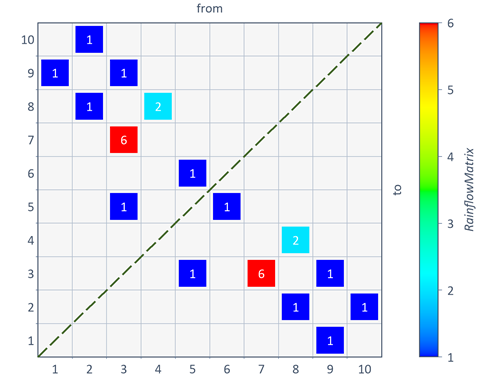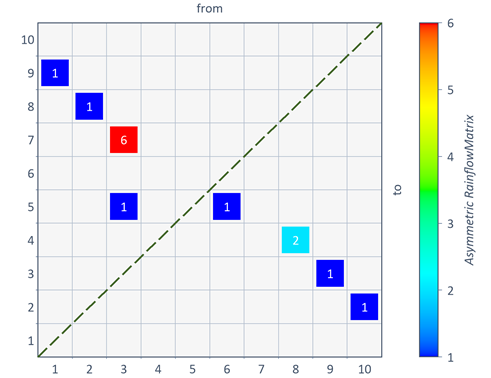RainflowMatrix (FPScript)
Determines the Rainflow Matrix for a data set.
Syntax
RainflowMatrix(DataSet, ClassLimits, Hysteresis, Options)
The syntax of the RainflowMatrix function consists of the following parts:
Part |
Description |
||||||||||||||
|---|---|---|---|---|---|---|---|---|---|---|---|---|---|---|---|
DataSet |
The data set for which a Rainflow matrix is to be determined. Permitted data structures are data series und signal. All real data types are permitted. If the argument is a list, then the function is executed for each element of the list and the result is also a list. |
||||||||||||||
ClassLimits |
Contains a data series, which contains the class limits for the count. If ClassLimits contains n values, this leads to n-1 closed classes. The first or the last value in ClassLimits provides the lowest or highest limit of the class division. Values that lie outside the limits are not counted. Permitted data structures are data series. All real data types are permitted. The unit has to be compatible with that of parameter DataSet. If the argument is a list, then the first element in the list is taken. If this is also a list, then the process is repeated. |
||||||||||||||
Hysteresis |
Specifies a hysteresis (range filter), which leads to suppression of small load alternations around a class limit. Only the crossings where the absolute value is as least as high as the hysteresis are counted. Permitted data structures are scalar value. All real data types are permitted. The unit has to be compatible with that of parameter DataSet. The value must be greater or equal to 0. If the argument is a list, then the first element in the list is taken. If this is also a list, then the process is repeated. |
||||||||||||||
Options |
Selects various output options for the Rainflow matrix. The argument Options can have the following values:
If the argument is a list, then the first element in the list is taken. If this is also a list, then the process is repeated. |
Remarks
If DataSet was specified as a data series, the result is a data matrix of 64-bit integer values with the Rainflow matrix. The rows in the matrix correspond to the "from" classes or range classes of the crossings and the columns correspond to the "to" classes or the mean value classes.
If DataSet was specified as a signal, the result is a signal series with a Z component whose X and Z components contain the class mid-points or the range- and mean value classes resulting from class limits.
To include the Residual in the matrix, a particularly well-balanced procedure is used. The residue is thereby divided at its highest point and the two halves are appended to each other in reverse order. This sequence then satisfies the algorithm and is included in the matrix [1].
Available in
Option Counting Procedures
Examples
RainflowMatrix(Signal(DataSet, 1), (11., Minimum(DataSet), Range(DataSet) / 10.), _
Range(DataSet) / 10. * 0.01, EXCLUDE_RESIDUE)
Calculates the Markov matrix of the 'DataSet' data series (see MarkovMatrixexample) with 10 classes of equal size.

RainflowMatrix(Signal(DataSet, 1), (11., Minimum(DataSet), Range(DataSet) / 10.), _
Range(DataSet) / 10. * 0.01, EXCLUDE_RESIDUE + COUNT_ASYMMETRIC)
Calculates the asymmetrical Rainflow matrix of the 'DataSet' data series with 10 classes of equal size.

See Also
References
[1] J.B. de Jonge: Counting Methods for the Analysis of Load Time Histories. In: NLR Memorandum SB-80-106 U. 1980.
[2] : Standard Practices for Cycle Counting in Fatigue Analysis. In: ASTM E1049-85(2017). ASTM International, West Conshohocken, PA, 2017,2017.
You might be interested in these articles
You are currently viewing a placeholder content from Facebook. To access the actual content, click the button below. Please note that doing so will share data with third-party providers.
More InformationYou need to load content from reCAPTCHA to submit the form. Please note that doing so will share data with third-party providers.
More InformationYou are currently viewing a placeholder content from Instagram. To access the actual content, click the button below. Please note that doing so will share data with third-party providers.
More InformationYou are currently viewing a placeholder content from X. To access the actual content, click the button below. Please note that doing so will share data with third-party providers.
More Information